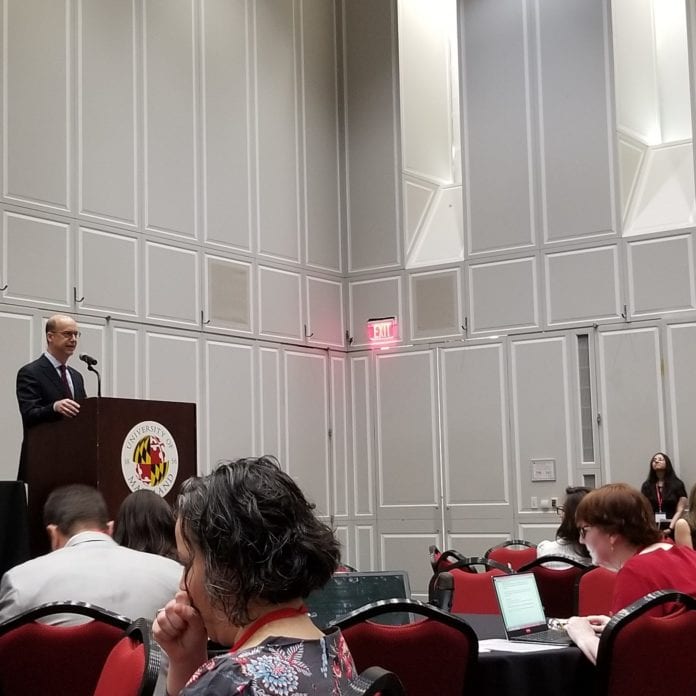COLLEGE PARK, MARYLAND — As wireless operators push forward with aggressive 5G roll-out plans, they will need a workforce that understands how to deploy increasingly complex network technologies, according to the Wireless Infrastructure Association.
WIA President and CEO Jonathan Adelstein said during a Wireless Connect event at the University of Maryland that the wireless industry is receiving broad government support across federal agencies to support network preparation and investment to prepare for 5G, and that more than 20 states have either passed small cell-related legislation to ease deployment, or have such rules in the works. But those changes in regulation to help speed up deployment can only come to fruition if the workforce exists to get equipment deployed.
Adelstein noted that a CTIA-commissioned report from Accenture has estimated that 5G will create 350,000 new construction jobs and a total of 850,000 jobs when considering suppliers and other partners — and that there is a skills gap in filling all of those jobs with knowledgeable employees.
“We need people in the field that understand how to deploy these networks, and understand RF,” Adelstein said — particularly complex RF environments, because cellular technologies are getting more complex as they evolve. While programs such as UMD’s are developing future network engineers, he said, there is a lack of training for the workforce that will be deploying the equipment in the field. “Nobody is really going that kind of training right now,” he added. To help bridge that gap, Adelstein said that much like in the electrical industry, the wireless industry is a “perfect” fit for apprenticeships.
While the telecom industry hasn’t made much use of apprenticeships in the past, he said, ” we need to bring that into our industry.”
WIA has been working to support such opportunities, as well as education and training in various forms through its Telecom Education Center, Adelstein said.
Tom Kane, president of infrastructure company NB+C said that the needs for workforce development and training at his company have evolved quite a bit over the past five years — both because of the evolution of network technology, but also evolving demands from the younger workforce. While previous generations might not have received or expected much in the way of on-the-job education and development, he said, Millennial workers do have expectations in those areas.
In addition, “5G is the hardest G. There’s no doubt about it,” said Kane, who received WIA’s excellence in leadership award at the event. “Concept to on-air has completely changed for all of us.” While the transitions from 1G to 2G to 3G and 4G were progressions of the same infrastructure — towers, rooftops and other ancillary uses — now much of the infrastructure is moving into the street right-of-way.
“It is super hard and super challenging,” he said, to go to a municipality with plans to putting up hundreds of nodes 30 feet above street level. “It will get easier,” Kane continued. “It will never get easy. That’s something you have to say. It’s a tremendous amount of infrastructure we’re putting out there. … Let’s put up smart stuff.” Otherwise, he said, the blow-back from putting up “junk” will affect the entire industry.
“We need to put up infrastructure that we would be comfortable with in our own community,” Kane said.
WIA also presented an award to Federal Communications Commissioner Michael O’Rielly as the “spectrum champion of the year” award and O’Rielly spoke on his ambitious spectrum agenda.
Adelstein cited in particular O’Rielly as a strong advocate for broadband deployment, and his work on helping to open up additional spectrum in a range of frequencies, from the Citizens Broadband Radio Service and the C-band spectrum to 3.45-3.55 GHz.
“The FCC must keep pace with market realities,” O’Rielly said. He said that over the last couple of years, the global focus on 5G spectrum shifted to the mid-band spectrum, which led to changes in the CBRS license terms and new discussions around allocation of C-band spectrum. In terms of millimeter wave, O’Rielly said that 26 GHz, 32 GHz, 42 GHz and 50 GHz ought to get rapid consideration from the FCC to move forward with making them available to the wireless industry.
In an update on the state of the CBRS, O’Rielly said that the spectrum is likely to be the first U.S. midband spectrum ready for 5G services — but, he said, he has been told that it may take until next year, at the earliest, for an auction of the Priority Access Licenses to take place. In the meantime, however, O’Rielly said that 3.5 GHz should be available under General Authorized Access, the unlicensed third tier of the spectrum sharing framework. “Significant progress” has been made in testing the two systems that will enable CBRS spectrum sharing, O’Rielly said: 3 Environmental Sensing Capability providers have completed testing and submitted their reports, so that review and certification of ESCs can be completed; Spectrum Access System testing is also ongoing, O’Rielly said, and commercial availability of GAA could come in the June timeframe.

